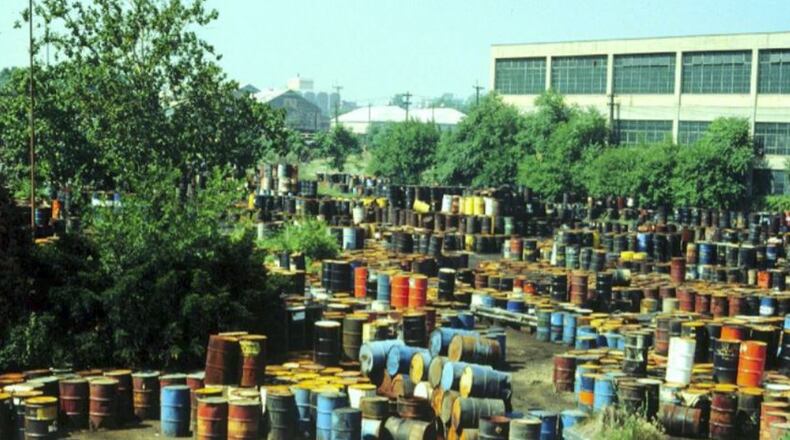Pollution leaving the site killed more than a million fish and water animals in the Great Miami River, with large amounts of chemicals seeping into the soil below it.
The site, at 500 Joe Nuxhall Blvd., now is a grass field with one small building. It no longer can be used for houses, apartments or other residential uses, although such things as ballfields, parking lots and roadways can be allowed.
So why would Hamilton city government, which battled in court for a cleanup, now want to buy part of the site?
To make sure someone else doesn’t buy it and do something irresponsible, City Manager Joshua Smith said in an interview.
“This is more of keeping it out of someone else’s hands,” Smith said.
Butler County several months ago planned to auction some of the land that was owned by a company that failed to pay taxes. The city urged the county not to auction it off.
“And they said, ‘Well, take it then, if you don’t want someone else to have it,” Smith said in an interview.
The county agreed not to auction the site if the city would make a relatively quick decision on whether it would take ownership of the land.
The city met with the trustee organization responsible for cleaning and monitoring the site, which liked the idea of Hamilton buying it, because they regularly work with the city, Smith said.
“I was just worried about the liability of it,” Smith said. So he asked Andrew Kolesar, an environmental lawyer with the firm Thompson Hine, who grew up in Lindenwald, to explain to council and the public on Wednesday the possible problems ownership could cause city government.
Kolesar said the city would have little liability as long as it doesn’t use the land for disallowed purposes or disturb the cap on top of it. Almost all of the liability belongs to the 100-plus organizations that are under a court decree to finance its cleanup and monitoring.
Kolesar said the state and federal Environmental Protection Agencies have written “comfort letters” for the city, stating that the trust and those 100-plus companies remain responsible for the site’s pollution, “not the city.”
City Council in January will consider making the purchase, perhaps at auction.
The Chem-Dyne site’s history
The property began a manufacturing site in the 1920s, and that continued until Chem-Dyne took over in the 1970s. Kolesar noted the nation’s significant environmental laws began in the 1970s. Also, the Superfund program, to deal with polluted sites was launched in 1980, “which is probably not a coincidence that Chem-Dyne closed in 1980, and went bankrupt,” he said.
Because Chem-Dyne was insolvent, state and federal regulators went to 174 companies and other organizations that had sent waste to the site. Those companies signed a consent decree to clean the property, and have paid $36 million through the decades so far on the cleanup. Today, 103 of those businesses that still exist remain responsible for financing monitoring of pollutants. Those include such large companies as Pfizer, BASF and DuPont.
The property’s location was especially concerning because it sits above the Great Miami Aquifer, a giant source of groundwater that holds 1.5 trillion gallons of water serves the needs of 3 million consumers for drinking water.
Under a court ruling, buildings were demolished, the many barrels were removed, upper layers of contaminated soil were removed during the 1980s, with a clay-and-plastic cap was placed over the site to keep rain from entering the soil below and pushing it down into the aquifer.
To eliminate significant groundwater contamination, a trust was formed that pumped water from beneath the land, cleansed it, and pumped it back underground, a process that continued until 2015.
Currently, regulators are monitoring chemical migrations from the property with the belief that “the concentrations in the ground water are low enough that there’s ... no real benefit of treating it, but it’s dispersing, it’s diluting, it’s degrading, and so just sort of naturally it will degrade (decrease).”
But the trust created to clean the site and monitor movement of pollutants “will be required to monitor that groundwater for many years to come, to make sure that nothing unexpected happens,” Kolesar said.
Ballfields, parking lots are allowed there, as long as the soil-and-plastic cap above the land, to protect rain from pushing pollution into the isn’t compromised.
Council Member Michael Ryan on Wednesday expressed concern about unforeseen costs the city could face: “I just don’t want to get a shock from the EPA, saying, ‘Well, congratulations on buying the site. By the way, we’ve got these three things we’re now responsible (for) doing.’”
Ryan recently read a five-year analysis of pollution on the site that he found reassuring about progress. But he said he was concerned about possible future changes that could affect who might be responsible for the site.
Kolesar promised to investigate that.
About the Author


